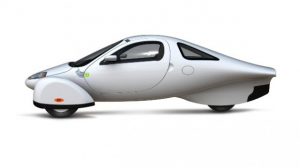Never-Charge Electric Vehicles

The Apterra 2e
Courtesy Apterra Mortors
The Aptera Series 2 vehicle is arguably the most efficient transportation ever created. The experimental car has a 1,000-mile battery range. It also generates 40 miles a day of range on the free power from its solar panels. It’s aerodynamic; its monocoque is lightweight and strong… and reportedly fun to drive. After having to liquidate in 2012, this innovative start-up is back with a crowdfunding campaign to restart development of its three-wheeled, two seater.
Each owner can reduce his or her carbon footprint by 14,000 ponds of CO2 per year according to Apterra’s CEO Chris Anthony. He combined his knowledge of batteries and wake board manufacture. The lightweight, eco-friendly resin infusion process that would be a perfect fit for lightweight composite structure for vehicles. With Steve Fambro, they developed a new monocoque safety cell structure prototype with two seats and three wheels.
In related news, Toyota, Sharp, and NEDO (New Energy and Industrial Technology Development Organization) have teamed up to test cars equipped with solar panels and batteries such that an electric vehicle can operate indefinitely without plugging in to recharge. For power, it employs advances in thin film technology, 0.03 mm thick solar panels mounted on curved roofs, hoods, and hatchbacks that generate up to 860 watts of power. A new development is that the vehicles will be able to charge when parked, and when in operation. While not yet suited for long-range driving, the technology is advancing driver independence from charging facilities.
Dethleffs is doing something similar, promoting a recreational vehicle (RV) that never needs to be recharged by the grid. Built on an Iveco Daily Electric chassis, clad with solar panels on its roof and sides, the recreational vehicle has 334 square feet of thin film solar panels generating up to 3,000 watts of electricity. Dethleffs 228-Ah sodium-nickel-chloride battery provides 100 miles of range.
